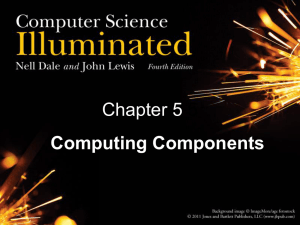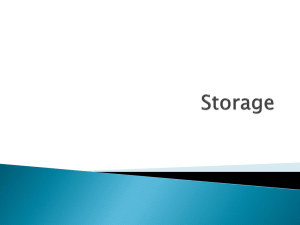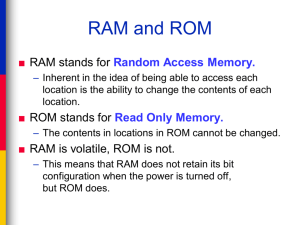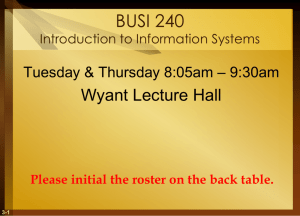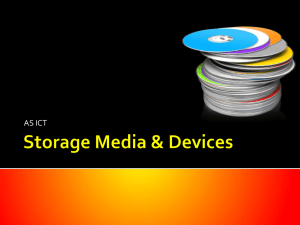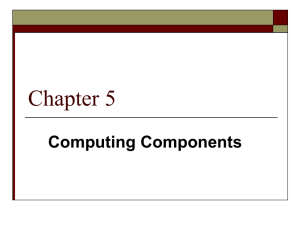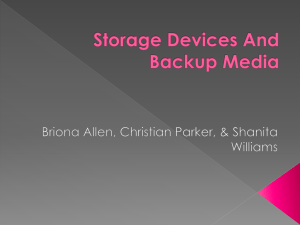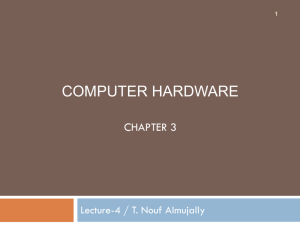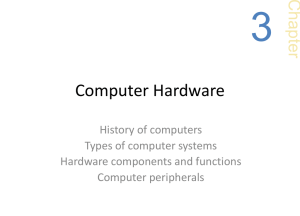Quiz on Ch.4 is at the end of Ch.4 slides
advertisement
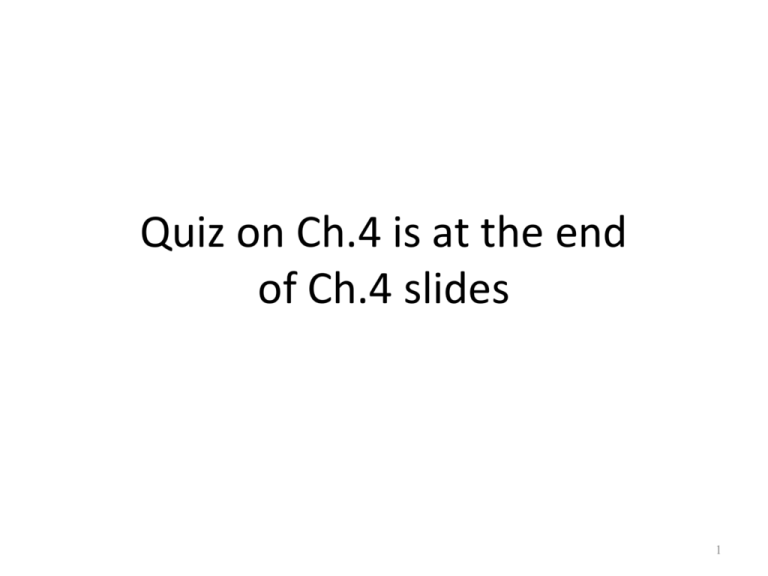
Quiz on Ch.4 is at the end of Ch.4 slides 1 Chapter 5 Computing Components Yet another layer of abstraction! Components Circuits Gates Transistors Chapter Goals • Read an ad for a computer and understand the jargon • List the components and their function in a von Neumann machine • Describe the fetch-decode-execute cycle of the von Neumann machine 3 Chapter Goals • Describe how computer memory is organized and accessed • Name and describe different auxiliary storage devices • Define three alternative parallel computer configurations 4 5.1 Individual Computer Components Consider the following ad: Insatavialion 640 Laptop Exceptional Performance and Portability 5 It’s just a madeup example! Computer Components What does all this jargon mean? • Intel® Core™ 2 Duo (2.66GHz/1066Mhz FSB/6MB cache) • 4GB Shared Dual Channel DDR2 at 800 MHz • 500 GB SATA Hard Drive at 5400RPM • 15.6” High Definition (1080p) LED Backlit LCD Display (1366 x 768) • 8X Slot Load DL DVD+/- RW Drive Be patient! You don't know • 14.8”W X 1.2”H X10.1” D, 5.6 lbs. them now, but you will get used to them. 6 Computer Components (cont.) • 512 MB ATI Mobility Radeon Graphics • 85 WHr Lithium Ion Battery • (2) USB 2.0, HDMI, 15-Pin VGA, Ethernet 10/100/1000 IEEE 1394 Firewire, Express Card, Audio line-in, line-out, mic-in • Microsoft® Windows 7® Professional • Microsoft® Office Home and Student 2007 • 36-Month subscription to McAfee Security Center Anti-virus 7 Multipliers What is a hertz? 8 To do in notebook for next time: • Read the entire Section 5.1 and take notes • Answer end-of-chapter questions 1-16, 26, 27, 28 9 Decimal vs. binary multipliers 1000 = 103 1,000,000 = 106 1,000,000,000 = 109 1024 = 210 1024*1024 = 220 1024*1024*1024 = 230 Rule: For memory capacities, the multipliers are binary, for everything else (speed, frequency, pixels, etc.) they are decimal k vs. K 10 Decimal vs. binary multipliers examples What is the meaning of: • 500 GB hard-disk • 54 Mbps wireless Ethernet • 3 GB of RAM • 8 Mega-pixel camera • 3.2 GHz CPU 11 5.2 Stored-Program Concept The von Neumann architecture is based on two fundamental ideas: 1. Instructions and data are the same, so they are stored in the same place (memory) 2. Information processing is different from information storage, so they are performed in different units (CPU, memory) 12 Memory Cells can be bits, nibbles, bytes, words Memory A collection of cells, each with a unique physical address Both addresses and contents are in binary Memory Addressability Is the # of bits in each cell addressable location What is the addressability of the memory pictured? Today, most computers’ memories are byte-addressable Arithmetic/Logic Unit = ALU Performs: • basic arithmetic operations such as add, subtract, increment, decrement, change sign • logical operations such as AND, OR, XOR, NOT Most modern ALUs have a small amount of very fast storage units called registers The information in them can be processed in one CLK cycle (i.e. fast) 15 Input/Output Units Input Unit A device through which data and programs from the outside world are entered into the computer; Can you name three? Output unit A device through which results stored in the computer memory are made available to the outside world Can you name two? 16 Control Unit Control unit It is the organizing force in the computer Implements the fetch-execute cycle Includes two important registers: • Instruction register (IR) →Contains the instruction that is being executed • Program counter (PC) → Contains the address of the next instruction to be executed ALU + Control Unit = CPU 17 Flow of Information Bus = A set of wires that connect all major units in a computer Data flow through a von Neumann architecture Bus width = # of bits that can be simultaneously transferred (i.e. in parallel) Cache (go back to laptop ad) 18 The Fetch-Execute Cycle Fetch the next instruction Decode the instruction Get data (if needed) Execute the instruction Remember: both instructions and data are stored in the same memory! Why is it called a cycle? 19 The Fetch-Execute Cycle According to the CPU’s machine language 20 We have covered pp. 125-132 in the text To do by next class in the notebook: Read and take notes: • John Vincent Atanasoff bio (p.126) Answer end-of-chapter questions 1 – 16, 24 - 28 21 RAM and ROM Random Access Memory (RAM) → each location: • can be accessed directly • can be changed (written) in real-time Read Only Memory (ROM) → each location: • can be accessed directly • cannot be changed (written) in real-time RAM is volatile, ROM is not EoL 22 Secondary Storage Devices Name a few … Why is it necessary to have secondary storage devices? 23 Secondary Storage Devices Why is it necessary to have them? • Saving data when computer is off • Volume … – “Mass storage” • Portability … • Reliability (backups) … • Modularity (add as you go) … 24 Magnetic Tape The first truly mass auxiliary storage device was the magnetic tape drive Tape drives have a major problem; can you describe it? Figure 5.4 A magnetic tape Magnetic Disks - HDD Tracks near center are more densely packed with information Seek time Time it takes for read/write head to be over right track Latency Time it takes for sector to be in position Access time = Seek time + latency Transfer rate (e.g. 100 MB/s) 27 Magnetic Disks - Removable History Floppy disks (Why "floppy"?) Year of invention: 1969 (8-inch) 1976 (5¼-inch) 1982 (3½-inch) 1.44 MB 28 Magnetic Disks - Removable Zip drives • Iomega, 1994 • 100 MB, 250 MB, 750 MB 29 Optical Disks CD (600 MB) A compact disk that uses a laser to read information stored optically on a plastic disk; data is evenly distributed around track CD-ROM read-only memory CD-DA digital audio CD-WORM or CD-R user can write once, read many times CD-RAM or CD-RW user can both write and read many times DVD (4.7 GB) Digital Versatile Disk, used for storing audio and video DL = dual layer → 8.5 GB Blu-Ray (25 GB) 30 Optical Disks Interesting difference between [FDD + HDD] and optical disks: – Data on optical disks is uniformly packed – Tracks near the center have less data than tracks near the periphery – To ensure a uniform transfer rate, the rotation speed changes as the read/write head moves in and out 31 Flash memory • Nonvolatile • Can be erased and rewritten – But there’s a rub: Flash Endurance • No moving parts! Thumb drives Solid State Drives (SSD) 32 Touch Screens Touch screen A computer monitor that can respond to the user touching the screen with a stylus or finger There are 4 types: – – – – Resistive Capacitive Infrared Surface acoustic wave (SAW) 33 Term paper • Read and take notes in notebook: pp.137-139 • Write a 4-page term paper, that includes a description, technical and commercial data (e.g. screen size, resolution, interfaces, price) of two touch screens of different types. • At the end of the paper, list in a reference section the websites or webpages you used. – The references must be referenced within the text of the paper! 34 Term paper Formatting rules: – Font: Times New Roman size 12 – Single-line (not 1.5, 2 or Multiple!) – Paragraphs: • No space before or after • No hanging lines • OK to indent the first line – Images: allowed 2 or 3, but keep them small – OK to leave an empty line in between Sections 35 5.3 Non-von Neumann architectures 36 Synchronous processing One approach to parallelism is to have multiple processors apply the same program to multiple data sets Figure 5.7 Processors in a synchronous computing environment 37 Pipelining Arranges processors in tandem, where each processor contributes one part to an overall computation Figure 5.8 Processors in a pipeline 38 Independent Processing with Shared Memory Communicate through shared memory Figure 5.9 Shared memory configuration of processors 39 Embedded Systems Embedded systems Computers that are dedicated to perform a narrow range of functions as part of a larger system Empty your pockets or backpacks. How many embedded systems do you have? 40 Ch. 5 - Synthesis – Data transfer rates What is a data transfer rate? “data rate” → units of data / units of time – – – – – – – bps (kbps, Mbps etc.) Bps (B/s, kBps, MB/s etc.) Blocks per second Characters per minute Pages per hour Frames per second (fps) 1x, 2x, 8x (optical disk read/write speeds) “transfer” → The data must travel from one place to another The data transfer rates mentioned in the text • p.121 → “…the hard drive can transfer data at a rate of 100MB per second” • p.122 → “…the modem is capable of processing 56,000 bits per second” • p.133 → “…we talk about hard disk transfer rates using megabytes per second and floppy disk transfer rates using kilobytes per second” Why aren’t the following data transfer rates? • • • • • • 3.2 GHz 400 MHz 7200 rpm 80 GB, 512 MB, 1.44 MB, 600 MB 0.28 mm (dot pitch) 1 Peta-FLOPS (FLoating-point OPerations per Second) 1015 How to convert ppm to bps Is ppm a data transfer rate? 22 ppm = 22 x pages / min = 22 x 3297 characters / 60 s = 1208.9* characters / s = 1208.9 x 8** bits / s = 9671.2 bps ≈ 9.6 kbps * Book Production Procedures for Today's Technology, by Fred Dahl, p.21 ** Assuming that characters are represented in Extended ASCII code Who am I? A law suit determined my legacy. What was it all about? There’s a new book about me: And here’s my rival from Germany: Konrad Zuse (http://inventors.about.com/library/weekly/aa050298.htm) 48 To do in notebook: read and take notes Ethical Issues Computer Hoaxes and Scams: What is the principal difference between a hoax and a scam? What are the most common complaints of Internet users about computer scams and hoaxes? What are the most serious crimes perpetrated on the Web? Why is it so difficult to police these schemes? 49 Homework Due Wednesday, Oct 27 : End of chapter exercises 37, 38, 46, 47, 48, 49, 63, 64, 65, 66 Thought Questions 1, 3 50
